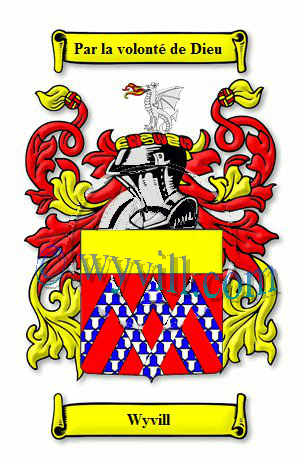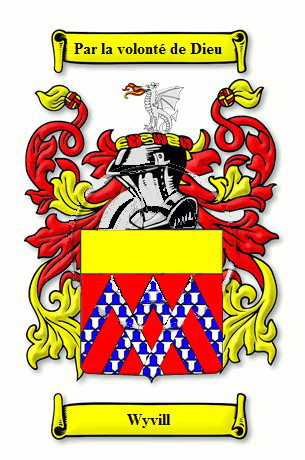Coat of Arms
 The surname of WYVILL has the arms recorded in Sir Bernard Burkes General Armory. Ulster King of Arms in 1884. 'Sir Marmaduke WYVILL of Constable Burton knighted by Queen Elizabeth I.'created a bart 25th November in the year 1611, now represented by Marmaduke WYVILL, Esq., of Constable Burton'. The barony is dormant but vests in a branch of the family long settled in America. Originally the coat of arms identified the wearer, either in battle or in tournaments. Completely covered in body and facial armour the knight could be spotted and known by the insignia painted on his shield, and embroidered on his surcoat, the draped garment which enveloped him. The earliest of the name on record appears to be Hugo de WITUILE who was listed as a tenant in the Domesday Book of 1086, and William de WITUILLA was recorded in London in 1273. Between the 11th and 15th centuries it became customary for surnames to be assumed in Europe, but were not commonplace in England or Scotland before the Norman Conquest of 1066. They are to be found in the Domesday Book of 1086. Those of gentler blood assumed surnames at this time, but it was not until the reign of Edward II (1307-1327) that second names became general practice for all people. Edward WYVILE of Yorkshire was listed in the Yorkshire Poll Tax of 1379. The Norman Conquest in England in the year of 1066 revolutionized our personal nomenclature. The old English name system was gradually broken up and old English names became less common and were replaced by new names from the continent. Most of the early documents deal with the upper classes who realised that an additional name added prestige and practical advantage to their status. Names of peasants rarely occurred in medieval documents. In 1086 the compilation of the Domesday Book was ordered by William the Conqueror (1027-87), king of England from 1066. He was born in Falaise, the bastard son of Robert, Duke of Normandy, by Arlette, a tanner's daughter. On his father's death in 1035, the nobles accepted him as a duke. When Edward the Confessor, King of England died in 1066, William invaded England that Autumn, on 14th October, 1066 killing Harold (who had assumed the title of King). English government under William assumed a more feudal aspect, the King's tenants-in-chief and all title to land was derived from his grants, and the Domesday Book contains details of the land settlements, and the names of the owners of such.
The surname of WYVILL has the arms recorded in Sir Bernard Burkes General Armory. Ulster King of Arms in 1884. 'Sir Marmaduke WYVILL of Constable Burton knighted by Queen Elizabeth I.'created a bart 25th November in the year 1611, now represented by Marmaduke WYVILL, Esq., of Constable Burton'. The barony is dormant but vests in a branch of the family long settled in America. Originally the coat of arms identified the wearer, either in battle or in tournaments. Completely covered in body and facial armour the knight could be spotted and known by the insignia painted on his shield, and embroidered on his surcoat, the draped garment which enveloped him. The earliest of the name on record appears to be Hugo de WITUILE who was listed as a tenant in the Domesday Book of 1086, and William de WITUILLA was recorded in London in 1273. Between the 11th and 15th centuries it became customary for surnames to be assumed in Europe, but were not commonplace in England or Scotland before the Norman Conquest of 1066. They are to be found in the Domesday Book of 1086. Those of gentler blood assumed surnames at this time, but it was not until the reign of Edward II (1307-1327) that second names became general practice for all people. Edward WYVILE of Yorkshire was listed in the Yorkshire Poll Tax of 1379. The Norman Conquest in England in the year of 1066 revolutionized our personal nomenclature. The old English name system was gradually broken up and old English names became less common and were replaced by new names from the continent. Most of the early documents deal with the upper classes who realised that an additional name added prestige and practical advantage to their status. Names of peasants rarely occurred in medieval documents. In 1086 the compilation of the Domesday Book was ordered by William the Conqueror (1027-87), king of England from 1066. He was born in Falaise, the bastard son of Robert, Duke of Normandy, by Arlette, a tanner's daughter. On his father's death in 1035, the nobles accepted him as a duke. When Edward the Confessor, King of England died in 1066, William invaded England that Autumn, on 14th October, 1066 killing Harold (who had assumed the title of King). English government under William assumed a more feudal aspect, the King's tenants-in-chief and all title to land was derived from his grants, and the Domesday Book contains details of the land settlements, and the names of the owners of such.
